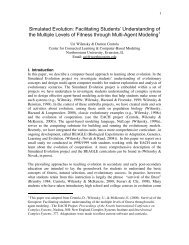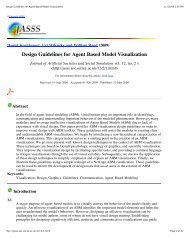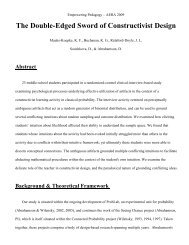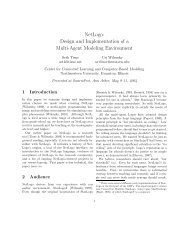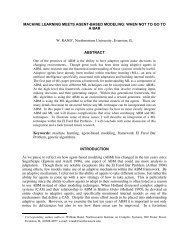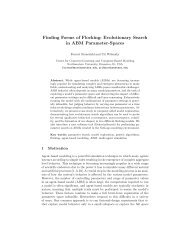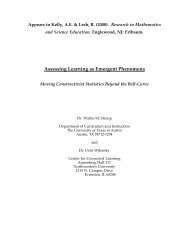printable form - The Center for Connected Learning and Computer ...
printable form - The Center for Connected Learning and Computer ...
printable form - The Center for Connected Learning and Computer ...
You also want an ePaper? Increase the reach of your titles
YUMPU automatically turns print PDFs into web optimized ePapers that Google loves.
<strong>The</strong>re are lots of possible answers to this question about what happens at real parties. <strong>The</strong> designer<br />
of this simulation thought that groups at parties don't just <strong><strong>for</strong>m</strong> r<strong>and</strong>omly. <strong>The</strong> groups are determined<br />
by how the individuals at the party behave. <strong>The</strong> designer chose to focus on a particular variable,<br />
called "tolerance":<br />
Tolerance is defined here as the percentage of people of the opposite sex an individual is<br />
"com<strong>for</strong>table" with. If the individual is in a group that has a higher percentage of people of the<br />
opposite sex than their tolerance allows, then they become "uncom<strong>for</strong>table" <strong>and</strong> leave the group to<br />
find another group.<br />
For example, if the tolerance level is set at 25%, then males are only "com<strong>for</strong>table" in groups that<br />
are less than 25% female, <strong>and</strong> females are only "com<strong>for</strong>table" in groups that are less than 25%<br />
male.<br />
As individuals become "uncom<strong>for</strong>table" <strong>and</strong> leave groups, they move into new groups, which may<br />
cause some people in that group to become "uncom<strong>for</strong>table" in turn. This chain reaction continues<br />
until everyone at the party is "com<strong>for</strong>table" in their group.<br />
Note that in the model, "tolerance" is not fixed. You, the user, can use the tolerance "slider" to try<br />
different tolerance percentages <strong>and</strong> see what the outcome is when you start the model over again.<br />
How to start over:<br />
1. If the "go" button is pressed (black), then the model is still running. Press the<br />
button again to stop it.<br />
2. Adjust the "tolerance" slider to a new value by dragging its red h<strong>and</strong>le.<br />
3. Press the "setup" button to reset the model.<br />
4. Press the "go" button to start the model running again.<br />
Challenge<br />
As the host of the party, you would like to see both men <strong>and</strong> women mingling within the groups.<br />
Adjust the tolerance slider on the side of the view to get all groups to be mixed as an end result.<br />
To make sure all groups of 10 have both sexes, at what level should we set the tolerance?<br />
Test your predictions on the model.<br />
NetLogo 3.0.2 User Manual<br />
Can you see any other factors or variables that might affect the male to female ratio within each<br />
group?<br />
Make predictions <strong>and</strong> test your ideas within this model. Feel free to manipulate more than one<br />
variable at a time.<br />
As you are testing your hypotheses, you will notice that patterns are emerging from the data. For<br />
example, if you keep the number of people at the party constant but gradually increase the<br />
Sample Model: Party 23







